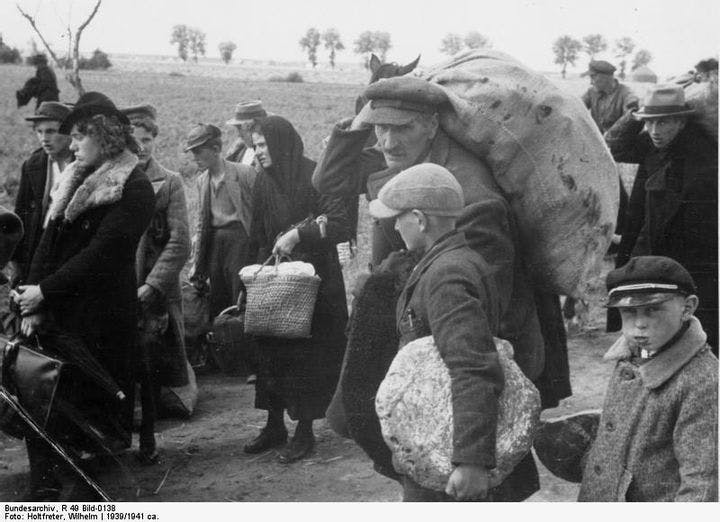Spring 2008
History Writ Small
– Aviya Kushner
Aviya Kushner looks at an intimate portrait by Mimi Schwartz of her father's life in Benheim, Germany, during World War II, and finds it "a beautiful read by a charming writer."
For one month in 1936, my grandfather worked in a bar in Bremen, Germany. The owner of that bar, who was not Jewish, risked plenty to pay my teenage grandfather for drying glasses and sweeping the floor. Decades later, he did my grandfather another favor, telling a committee in Bremen, “Yes, I knew Zigmund Traum. He worked for me in my bar. On this and this date.” Because of that testimony, my grandfather received reparation checks for the rest of his life. The money could not compensate for the murders of two parents and four brothers, but it was an acknowledgment of what had happened.
Such small episodes—my grandfather’s month of illegal work, the bar owner’s walk to the reparation committee’s headquarters—are part of the Holocaust’s history, too. In Good Neighbors, Bad Times, Mimi Schwartz tells the stories “that history has no time for as it paints the broad brush strokes of the past.” These stories take place in Benheim (Schwartz changed the name), the German farming community where her father was born in 1898, when half the town’s 1,200 residents were Jewish.
After he emigrated to Queens in 1937, Schwartz’s father insisted that once his hometown “was the best place for Jews!” At the same time, he spent hours on the phone persuading others to help him in efforts to assist Jews still stuck in Hitler’s Germany to leave, and fast. Schwartz, a professor emerita of the writing program at Richard Stockton College in New Jersey, takes us into the kitchens and gathering places of Germans and Jews alike, accepting drinks, cakes, and stories, in an effort to separate truth from lies in her father’s account of good neighbors in a German village.
A hand-typed article by her father that she discovers tucked in an old file after his death describes life in the village before Hitler, when it was common practice for neighbors to help each other with feeding the chickens, milking the cows, and stoking coal. Orthodox Jewish residents who commuted by train to Pforzheim regularly converted one car into a prayer car, Schwartz’s father wrote, “much to the astonishment of Christian travelers. No one shied away from laying tefillin [leather boxes Orthodox men strap on their arms and heads during morning prayers]; one prayed as if one were in a synagogue.”
But as the Nazis’ power grew during the 1930s, many Benheim Jews fled. After her father’s death, Schwartz seeks them out to learn what happened in the place they left behind. In Israel, she hears about Benheim Christians who rescued a Torah during Kristallnacht in 1938. From survivors in Vermont, she learns that there are actually two extant Benheim Torahs. And she hears stories that confirm that brave acts by non-Jews weren’t confined to her father’s village. One Benheim survivor, a woman named Ilse Loew, tells Schwartz about a woman from Holland she met recently who had hidden Jews during the war: “One day someone knocked on her door—it was either the Dutch police or a Nazi—and demanded she hand over the Jews. She offered him a cup of coffee and while he drank, she got a gun and killed him.” An undertaker friend stowed the body in a coffin with another corpse.
But good neighbors are not the whole story, either. There were many seemingly nice local ladies who moved into vacant Jewish homes and live there still, tending flowers. Gradually, Schwartz pieces together the story of who let who hide whom. The pharmacist who initially sheltered Loew and her future husband during Kristallnacht soon sent them out into the streets, where Nazi thugs roamed. Benheim men sent to Dachau all returned in March 1939—thin, but alive. Most sent to concentration camps later did not return. Of the 89 Benheimers who were deported in 1940–41, 87 were murdered.
Those who read widely in the crowded field of Holocaust studies will find some facets of this book familiar. Like Daniel Mendelsohn, author of The Lost: A Search for Six of Six Million (2006), Schwartz goes to elderly neighbors and relatives, and finally travels thousands of miles, to hear the stories she was “allergic to” as a kid. These stories may be less reliable than historical data, she admits, but “I liked how one person’s memory bumped another, muddying the moral waters of easy judgment.” This book of moments and little stories surprises and horrifies, soothes and disturbs. But it is, above all, a beautiful read by a charming writer. And it reminds us that behind every story is the flawed human being who told it.
* * *
Aviya Kushner is the author of the forthcoming book, And There Was Evening, And There Was Morning, about the experience of reading the Bible in English for the first time after a lifetime of reading it in Hebrew.
Reviewed: "Good Neighbors, Bad Times: Echoes of My Father's German Village" by Mimi Schwartz, University of Nebraska Press, 2007.
Photo courtesy of Wikimedia Commons
